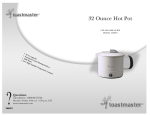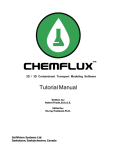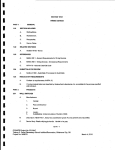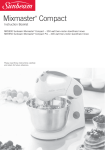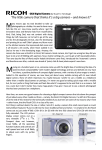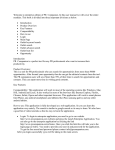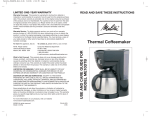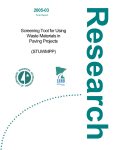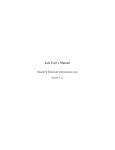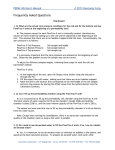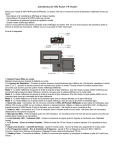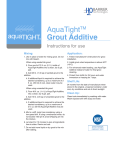Download Evaluating Effectiveness of Chemicals for Soil Stabilization1
Transcript
Designation: D 4609 – 94 AMERICAN SOCIETY FOR TESTING AND MATERIALS 100 Barr Harbor Dr., West Conshohocken, PA 19428 Reprinted from the Annual Book of ASTM Standards. Copyright ASTM Standard Guide for Evaluating Effectiveness of Chemicals for Soil Stabilization1 This standard is issued under the fixed designation D 4609; the number immediately following the designation indicates the year of original adoption or, in the case of revision, the year of last revision. A number in parentheses indicates the year of last reapproval. A superscript epsilon (e) indicates an editorial change since the last revision or reapproval. SPEL Special Products Evaluation List3 T 88 Particle Size Analysis of Soils3 T 89 Determining the Liquid Limit of Soils3 T 90 Determining the Plastic Limit and Plasticity Index of Soils3 T 99 Moisture-Density Relations of Soils, Using a 5.5-lb (2.5-kg) Rammer and a 12-in. (305-mm) Drop3 T 208 Unconfined Compressive Strength of Cohesive Soil3 T 265 Laboratory Determination of Moisture Content of Soils3 1. Scope * 1.1 This guide describes laboratory techniques for evaluating the effectiveness of chemicals for improving the engineering properties of fine-grained soils. 1.2 Effectiveness is assessed by comparing the unconfined compressive strength (UCS), moisture susceptibility, and moisture-density relationships (MD) of treated and untreated soils. 1.3 The values stated in SI units are to be regarded as the standard. The inch-pound units given in parentheses are for information only. 1.4 This standard does not purport to address all of the safety concerns, if any, associated with its use. It is the responsibility of the user of this standard to establish appropriate safety and health practices and determine the applicability of regulatory limitations prior to use. 3. Summary of Guide 3.1 Chemical soil stabilizers are screened by comparing the results of a suite of engineering soil tests conducted on untreated soil and the same soil treated at appropriate amounts of the material being evaluated. Effectiveness is assessed by comparing the Atterberg limits, MD, USC, and resistance to moisture of treated and untreated soil samples. 2. Referenced Documents 2.1 ASTM Standards: D 421 Practice for Dry Preparation of Soil Samples for Particle Size Analysis and Determination of Soil Constants2 D 422 Method for Particle-Size Analysis of Soils2 D 698 Test Methods for Moisture-Density Relations of Soils and Soil-Aggregate Mixtures Using 5.5-lb (2.49-kg) Rammer and 12-in. (305-mm) Drop2 D 2166 Test Method for Unconfined Compressive Strength of Cohesive Soil2 D 2216 Method for Laboratory Determination of Water (Moisture) Content of Soil, Rock, and Soil-Aggregate Mixtures2 D 2217 Practice for Wet Preparation of Soil Samples for Particle Size Analysis and Determination of Soil Constants2 D 3877 Test Methods for One-Dimensional Expansion, Shrinkage, and Uplift Pressure of Soil-Lime Mixtures2 D 4318 Test Method for Liquid Limit, Plastic Limit, and Plasticity Index of Soils2 2.2 AASHTO Documents: 4. Significance and Use 4.1 This guide is intended to assist users and producers of chemicals, soil modifiers, and stabilizers in the evaluation of a product’s potential for improving a soil’s engineering properties (such as, deformation under load, shear strength, and volume stability). 4.2 The results of these tests can be used to make a decision to continue experimentation to assess longevity, durability, and practical value, and establish appropriate rates of application for field trials. 5. Apparatus 5.1 Harvard Miniature Compaction Apparatus, or apparatus for preparing remolded specimens for UCS as described in Section 4 of Test Method D 2166. For instructions on calibration, see Annex A1. 6. Sampling and Test Specimens 6.1 Obtain a 150-kg (300-lb) supply or have easy access to four or five soil and soil-aggregate materials as reference materials for stabilizer evaluations. These samples should represent two or more fine-grained soils of different clay mineralogy that are widely distributed and would be likely candidates for stabilization. One or two of the samples could 1 This guide is under the jurisdiction of ASTM Committee D-18 on Soil and Rock and is the direct responsibility of Subcommittee D18.15 on Stabilization with Admixtures. Current edition approved Sept. 15, 1994. Published November 1994. Originally published as D 4609 – 86. Last previous edition D 4609 – 86. 2 Annual Book of ASTM Standards, Vol 04.08. 3 Available from American Association of State Highway and Transportation Officials, 444 N. Capitol St., NW, Suite 225, Washington, DC 20001. *A Summary of Changes section appears at the end of this standard. 1 D 4609 represent the minus No. 10 fraction of plentiful marginal aggregates in need of beneficiation. 6.2 Review literature and test results provided by the material manufacturer or supplier. 6.3 Consult publications such as Special Products Evaluation List (SPEL) or other product evaluation or qualified products lists maintained by state highway agencies.4 6.4 If background search demonstrates that the subject material has promise, proceed with testing program. 7.3 On approximately 3 kg (7 lb), determine optimum moisture and maximum density in accordance with Test Methods D 698. 7.4 On approximately 1 kg (2.2 lb), as described in the calibration procedure given in Annex A1, determine with the Harvard apparatus the number of tamps and the spring pressure required to duplicate the standard density obtained by Test Methods D 698. 7.5 Prepare a 500-g (1-lb) batch at optimum moisture content. As soon as the mixing is completed, divide the mixture into three approximately equal portions. Perform liquid and plastic limit tests on one portion after air-drying overnight, on another after overnight storage at high-humidity, and on the other after 7 days of curing at high humidity. 7.6 On approximately 3600 g, determine expansion in accordance with Test Methods D 3877. 7.7 On approximately 1 kg (2.2 lb), with the Harvard apparatus, prepare six five-layer specimens (required for acceptable homogeneity) compacted to Test Methods D 698 density, and determine moisture absorption and unconfined compressive strength as described in Annex A2. 7. Procedure 7.1 Obtain 20-kg (45-lb) portions of two or more soil samples selected in 6.1 for an evaluation program. This quantity of soil will provide sufficient material for tests on the untreated soil and for soil-chemical mixtures at three rates of application: the amount recommended by the supplier, and amounts more and less than recommended. NOTE 1—All the tests recommended in 7.2 do not need to be conducted at all four rates of application (raw soil or zero rate, recommended rate, a rate more than recommended, a rate less than recommended.) NOTE 2—The 20-kg recommended sample size is from the following scenario: Two compaction tests (untreated and optimum rate) Calibration of Harvard Apparatus Atterberg limits (untreated and of optimum rate) Expansion (untreated and optimum rates) Unconfined Compressive Strength (untreated and three rates of treatment) Reserve for rerun of any test 6 1 1 2 4 8. Interpretations of Results 8.1 The recommendations in 8.1.1-8.1.5 are provided to evaluate whether a chemical additive has improved the engineering properties of fine-grained soils. Changes in one or more, but not necessarily all, of the properties in 8.1.1-8.1.5 may be used to judge effectiveness. The results of these tests may or may not be useful for determining the costeffectiveness or practical value of the chemical treatment; that decision will most probably need to be made after additional testing and data analysis. 8.1.1 Particle-Size Analysis—For chemical stabilizers whose mechanism is through cementing fine particles together, a shift in the particle-size distribution curve demonstrating a coarsening or granulation of the soil may be interpreted as an improvement in engineering properties. Particle-size analysis should be performed on the treated material after an appropriate curing period has elapsed. kg kg kg kg kg 6 kg ____ 20 kg 7.2 Test each untreated soil by the several test methods listed in 7.2.1 through 7.2.6. Perform the same tests on soil-chemical mixtures. For each rate of additive, five batches of soil-chemical mixture are required. Prepare a batch by combining in a mechanical mixer carefully weighed portions of soil, additive, and water. Blend thoroughly (normally for about 5 min) to produce a high degree of homogeneity. Prepare each batch and test separately as follows: 7.2.1 Moisture Content—Method D 2216 or T 265. 7.2.2 Particle-Size Analysis of Soils—Method D 422 or T 88. 7.2.3 Liquid Limit, Plastic Limit, and Plasticity Index—Test Method D 4318 or T 89. 7.2.4 Moisture-Density Relations—Test Methods D 698 (Method A) or T 99 (Method A) (see Note 3). 7.2.5 Volume Change—Test Methods D 3877 (see Note 4). 7.2.6 Unconfined Compressive Strength (see Note 5)—Test Method D 2166 or T 208. NOTE 6—If mechanical pulverization using Practice D 421 is too severe for treated samples, Practice D 2217 may be used. 8.1.2 Liquid and Plastic Limits and Plasticity Index— Significant reduction of liquid limit and plasticity index is indicative of improvement. Rendering a soil, having a plasticity index, of lesser plasticity or nonplastic by chemical treatment is a significant improvement. 8.1.3 Moisture-Density Relations—Improving soil compactability, that is, reducing the optimum moisture content or increasing the maximum dry density, is often of engineering significance. Lowering the optimum moisture content would be considered beneficial because frequently water must be purchased, or in any event transported, and distributed on the soil, requiring the use of motor fuel and time. 8.1.3.1 An increase in maximum dry density would indicate that an increase in strength was afforded by chemical treatment or that a target density could be achieved with less compactive effort. The single-operator precision for Test Methods D 698 is 1.9 % for maximum density and 9.5 % for optimum moisture NOTE 3—The sample may be reused and water added for successive points on the moisture-density curve if the soil material is not fragile and will not reduce in particle size due to repeated compaction or is not a heavy-textured clay into which it is difficult to incorporate water. NOTE 4—Although this test method is for soil-lime mixtures, other stabilizing admixtures may be used. NOTE 5—Specimen preparation and determination of moisture absorption are described in Annex A2. The moisture absorption specimens are also used for determining unconfined compressive strength, which is determined in accordance with the methods indicated in 7.2.1-7.2.6. 4 Illinois, Louisiana, and New Jersey are three states that publish such lists. 2 D 4609 content; consequently, a change in optimum moisture content of greater than about 15 % from the optimum for the untreated soil and a change in maximum density of about 80 kg/m3 (5 pcf) from the untreated may be interpreted as a result of chemical treatment because the observed changes are greater than the expected experimental error. 8.1.4 Unconfined Compressive Strength (UCS) and Moisture Absorption—Unconfined compressive strength criteria have been established for soil-stabilizer mixtures featuring lime, cement, and lime-flyash by various road building agencies.5 However, these criteria are used primarily to ensure durable soil-stabilizer mixtures. For the purposes of this guide, it is suggested that an increase in UCS of 345 kPa (50 psi) or more due to chemical treatment be considered effective. Also, if specimens do not slake during immersion, the treatment may be effective; and if no significant strength is lost due to immersion, the treatment may be effective for waterproofing soils. 8.1.5 Volume Change—Distress to pavements and structures is prevalent in areas where subgrade soils undergo significant volume changes with changes in moisture regime; that is, shrink with decreases in moisture and swell with increases in moisture. If treatment by the chemical being evaluated achieves the desired control of volume changes, the material may be judged effective. 9. Keywords 9.1 chemical screening; Harvard apparatus; liquid limit; moisture content; moisture-density; particle size; plastic limit; plasticity index; soil stabilization; unconfined compressive strength; volume change 5 These criteria are summarized in FHWA-ID-80-2, “Soil Stabilization in Pavement Structures—A User’s Manual,” available from the Superintendent of Documents, U.S. Government Printing Office, Washington, DC 20402. ANNEXES (Mandatory Information) A1. CALIBRATION OF THE HARVARD MINIATURE COMPACTION APPARATUS A1.1 In order to prepare moisture absorption and unconfined compressive strength test specimens having the required standard AASHTO T99 density, it is first necessary to calibrate the Harvard apparatus to determine the correct number of tamps per layer and to regulate the tamper springs so that tamping pressures of 10 kg (20 lb), 15 kg (30 lb), 20 kg (40 lb) can be utilized. Normally, ten or more tamps per layer are required. The calibration is illustrated in Fig. A1.1, which presents moisture-density curves for an experimental soil. The two curves for the Harvard method involve two different combinations of tamper spring loadings and numbers of tamps per layer. A1.2 For the calibration, prepare a soil-water mixture from approximately 1000 g of soil and the amount of water required for the AASHTO T 99 optimum moisture content. Place this mixture in a suitable container to prevent moisture loss, and remove an individual portion of about 150 g (0.3 lb) for the first compaction trial. From this portion, compact a five-layer specimen by the procedure given in A2.2.1-A2.2.8, using an arbitrary combination of number of tamps and tamper spring pressure. Remove the specimen from the mold with the ejector, slice into three or more portions, and determine the actual moisture content by Test Method D 2216. A1.2.1 Knowing the volume, the wet weight, and the moisture content of the compacted specimen, compute the dry density and compare with that from the AASHTO T 99 procedure. Using a second portion of the moist mixture, prepare a new specimen at another combination of number of tamps and tamping pressure, and repeat this process with additional portions until a density is obtained that is within 16 FIG. A1.1 Comparison of Compaction Methods kg/m3 (1 pcf) of the AASHTO T 99 density. This combination is then used in the preparation of test specimens, Annex A2. 3 D 4609 A2. SPECIMEN PREPARATION AND TEST PROCEDURE FOR MOISTURE ABSORPTION AND UNCONFINED COMPRESSIVE STRENGTH from the compacted soil. A2.2.5 Remove the mold from the base and carefully trim away the excess soil from the top and bottom of the mold. A2.2.6 Weigh the mold containing the compacted soil to the nearest 0.1 g. If inch-pound units for density are needed, it is convenient to use a tare weight equal to the weight of the empty mold, as then the resulting net weight in grams is numerically equal to the wet density of the compacted soil, in pounds per cubic foot. A2.2.7 Remove the specimen from the mold with the ejector, weigh, wrap in plastic food-wrapping material, and place in a high-humidity chamber at room temperature (73 6 2.0°F (23.0 6 1.1°C)) for the desired curing period. A2.1 Preparation of specimens for the determinations of moisture absorption and unconfined compressive strength requires about 1000 g of soil-water or soil-additive-water mixture. In preparing this mixture in a mechanical mixer, the amount of water used should be from 0.5 to 3.0 % in excess of that required for the optimum moisture content, to compensate for evaporation losses. The exact amount of excess water will depend on the humidity and other laboratory conditions. A2.2 Using this mixture and employing the combination of number of tamps and tamping spring pressure as determined in the calibration procedure, prepare six test specimens as follows:6 A2.2.1 With the mold and collar clamped to the base, place the amount of loose soil required for one layer in the mold. For a five-layer specimen, two slightly heaping teaspoonfuls will be required for each layer. Level the surface of the loose soil by pressing lightly with a wood plunger. A2.2.2 Insert the tamper in the mold until it is in contact with the surface of the soil, and press down firmly until the spring starts to compress. Release the force and shift the tamper to a new position. Apply each of the first four tamps in separate quadrants of the soil surface, and adjacent to the mold. The fifth tamp should be in the center, making one complete coverage. Repeat this tamping cycle until the desired number of tamps has been applied. Apply the tamps at the approximate rate of 10 tamps per 15 s. A2.2.3 Add and tamp the next layer, and repeat the procedure until the required number of compacted layers has been placed. The top layer should extend at least 6 mm (1/4 in.), but not more than 16 mm (5/8 in.) into the extension collar. A2.2.4 Transfer the mold assembly to the collar remover and release the clamps. Press down firmly on the piston and at the same time pull up on the handle, prying the collar loose NOTE A2.1—Other curing conditions may be used that simulate the environment under which the treated mixture will be cured in the field or field achievable conditions, such as partial air-drying which may be required to make the chemical effective. Curing methods or conditions should be reported along with other test results. A2.2.8 Between the compaction of the third and fourth specimens, take a 100-g (0.2-lb) sample from the remaining loose mixture and determine the actual moisture content by Test Method D 2216. A2.2.9 At the completion of the curing period, remove the wrapping material from three of the specimens, weigh the specimens, immerse in water for 2 days, remove from the water, surface-dry by blotting with a towel, and reweigh. Any gain in weight due to immersion represents the moisture absorption; calculate and record for each specimen as a percentage of the dry weight of the specimen. If appreciable disintegration or slaking of an immersed cylinder occurs, accurate determination of absorbed moisture is not possible and the record should so indicate. A2.2.10 After weighing as indicated above, test the three specimens for unconfined compressive strength in accordance with Test Method D 2166. A2.2.11 After testing the three immersed specimens, remove the remaining three specimens from the curing chamber, unwrap, weigh, and test for unconfined compressive strength in accordance with Test Method D 2166. 6 With the exception of the height of the top soil layer that extends into the mold collar, A2.2.3, the first six steps of this procedure are taken from a suggested method of test in Special Procedures for Testing Soil and Rock for Engineering Purposes, ASTM STP 479, ASTM, 1970, pp. 101–103. 4 D 4609 SUMMARY OF CHANGES This section identifies the principle changes to this guide that have been incorporated since the last issue. (1) Portion of title was changed from “Screening Chemicals” to “Evaluating Effectiveness of Chemicals”. (2) Keywords section was added. The American Society for Testing and Materials takes no position respecting the validity of any patent rights asserted in connection with any item mentioned in this standard. Users of this standard are expressly advised that determination of the validity of any such patent rights, and the risk of infringement of such rights, are entirely their own responsibility. This standard is subject to revision at any time by the responsible technical committee and must be reviewed every five years and if not revised, either reapproved or withdrawn. Your comments are invited either for revision of this standard or for additional standards and should be addressed to ASTM Headquarters. Your comments will receive careful consideration at a meeting of the responsible technical committee, which you may attend. If you feel that your comments have not received a fair hearing you should make your views known to the ASTM Committee on Standards, 100 Barr Harbor Drive, West Conshohocken, PA 19428. 5






